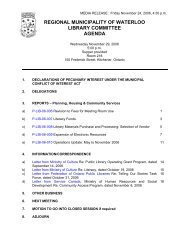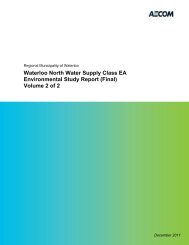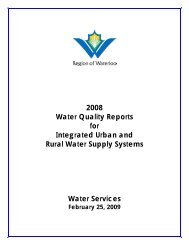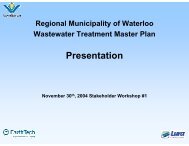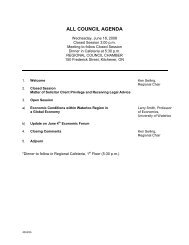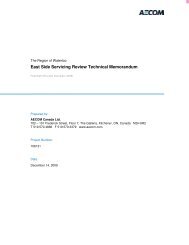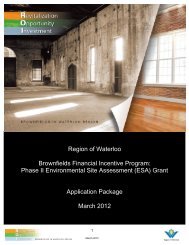Sam Ziemann From - Region of Waterloo
Sam Ziemann From - Region of Waterloo
Sam Ziemann From - Region of Waterloo
You also want an ePaper? Increase the reach of your titles
YUMPU automatically turns print PDFs into web optimized ePapers that Google loves.
August 26, 2011<strong>Sam</strong> <strong>Ziemann</strong>Page 7 <strong>of</strong> 12Reference: Fluid Transient Analysis for Strange Street Raw Water Supply System – Draft TechnicalMemorandumwater supply system piping from the K18/K19 Well House to the Strange StreetReservoir.The point where flow conditions transition from full pipe/pressurized flow to partially fullpipe/gravity flow conditions represents a boundary condition for the fluid transient modelas the model is limited to performing computations under pressure flow conditions.In order to perform the existing conditions transient analysis for the SSRWSS, themodel piping was truncated in the model at the location <strong>of</strong> the pressure sustaining valveand a Discharge to Atmosphere element was added to represent this transition point.The model was then rerun.Existing System Transient AnalysisThe first stage <strong>of</strong> the transient analysis was to develop and analyze scenarios <strong>of</strong> theexisting system for worst case transients. The following operational scenarios thatwould result in a change in steady-state flows were evaluated:1. Simultaneous shut-down <strong>of</strong> all wells due to power failure2. Sudden shut-down <strong>of</strong> one well (K18)3. Start-up <strong>of</strong> one well (K18) during normal operations (5 s start-up)Scenario 1 – Simultaneous shut-down <strong>of</strong> all wells due to power failureScenario 1 modeled a power failure (pump trip) event with all <strong>of</strong> the well pumps inoperation. The sudden shut-down <strong>of</strong> the well pumps induced a negative pressure wavethat propagated downstream. Figures 3a and 3b, which illustrate the pressure and headexperienced along the raw water supply system piping from the K18/K19 Well House tothe end <strong>of</strong> the truncated model, indicate that full vacuum conditions and columnseparation (macro-cavitation) occur along almost the entire segment <strong>of</strong> watermain.Macro-cavitation conditions occur when the negative pressures in the watermain dropor fall to the vapour pressure <strong>of</strong> the fluid. This phenomenon, which is known as columnseparation, results in the formation <strong>of</strong> large pockets <strong>of</strong> vapour within the watermain.Later, on the returning upsurge, these vapour pockets can collapse violently and thehigh pressure caused by the two liquid columns coming together can cause watermainruptures or damage to system components. Column separation places undesirablestresses on piping systems and should be avoided whenever possible.Scenario 2 – Well K18 Sudden Shut-downScenario 2 modeled a sudden shut-down event with one well in operation. This scenariois intended to represent normal operating conditions and assumes the wells within thesystem are shut-down one at a time. For this scenario the shut-down <strong>of</strong> Well K18 wasevaluated. Well K18 was chosen because it is the greatest distance away from the end



